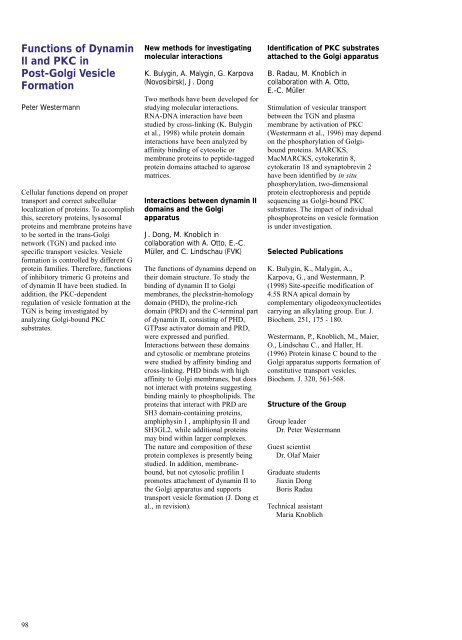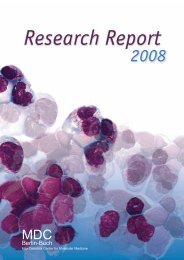Create successful ePaper yourself
Turn your PDF publications into a flip-book with our unique Google optimized e-Paper software.
Functions of Dynamin<br />
II and PKC in<br />
Post-Golgi Vesicle<br />
Formation<br />
Peter Westermann<br />
Cellular functions depend on proper<br />
transport and correct subcellular<br />
localization of proteins. To accomplish<br />
this, secretory proteins, lysosomal<br />
proteins and membrane proteins have<br />
to be sorted in the trans-Golgi<br />
network (TGN) and packed into<br />
specific transport vesicles. Vesicle<br />
formation is controlled by different G<br />
protein families. Therefore, functions<br />
of inhibitory trimeric G proteins and<br />
of dynamin II have been studied. In<br />
addition, the PKC-dependent<br />
regulation of vesicle formation at the<br />
TGN is being investigated by<br />
analyzing Golgi-bound PKC<br />
substrates.<br />
98<br />
New methods for investigating<br />
molecular interactions<br />
K. Bulygin, A. Malygin, G. Karpova<br />
(Novosibirsk), J. Dong<br />
Two methods have been developed for<br />
studying molecular interactions.<br />
RNA-DNA interaction have been<br />
studied by cross-linking (K. Bulygin<br />
et al., 1998) while protein domain<br />
interactions have been analyzed by<br />
affinity binding of cytosolic or<br />
membrane proteins to peptide-tagged<br />
protein domains attached to agarose<br />
matrices.<br />
Interactions between dynamin II<br />
domains and the Golgi<br />
apparatus<br />
J. Dong, M. Knoblich in<br />
collaboration with A. Otto, E.-C.<br />
Müller, and C. Lindschau (FVK)<br />
The functions of dynamins depend on<br />
their domain structure. To study the<br />
binding of dynamin II to Golgi<br />
membranes, the pleckstrin-homology<br />
domain (PHD), the proline-rich<br />
domain (PRD) and the C-terminal part<br />
of dynamin II, consisting of PHD,<br />
GTPase activator domain and PRD,<br />
were expressed and purified.<br />
Interactions between these domains<br />
and cytosolic or membrane proteins<br />
were studied by affinity binding and<br />
cross-linking. PHD binds with high<br />
affinity to Golgi membranes, but does<br />
not interact with proteins suggesting<br />
binding mainly to phospholipids. The<br />
proteins that interact with PRD are<br />
SH3 domain-containing proteins,<br />
amphiphysin I , amphiphysin II and<br />
SH3GL2, while additional proteins<br />
may bind within larger complexes.<br />
The nature and composition of these<br />
protein complexes is presently being<br />
studied. In addition, membranebound,<br />
but not cytosolic profilin I<br />
promotes attachment of dynamin II to<br />
the Golgi apparatus and supports<br />
transport vesicle formation (J. Dong et<br />
al., in revision).<br />
Identification of PKC substrates<br />
attached to the Golgi apparatus<br />
B. Radau, M. Knoblich in<br />
collaboration with A. Otto,<br />
E.-C. Müller<br />
Stimulation of vesicular transport<br />
between the TGN and plasma<br />
membrane by activation of PKC<br />
(Westermann et al., 1996) may depend<br />
on the phosphorylation of Golgibound<br />
proteins. MARCKS,<br />
MacMARCKS, cytokeratin 8,<br />
cytokeratin 18 and synaptobrevin 2<br />
have been identified by in situ<br />
phosphorylation, two-dimensional<br />
protein electrophoresis and peptide<br />
sequencing as Golgi-bound PKC<br />
substrates. The impact of individual<br />
phosphoproteins on vesicle formation<br />
is under investigation.<br />
Selected Publications<br />
K. Bulygin, K., Malygin, A.,<br />
Karpova, G., and Westermann, P.<br />
(1998) Site-specific modification of<br />
4.5S RNA apical domain by<br />
complementary oligodeoxynucleotides<br />
carrying an alkylating group. Eur. J.<br />
Biochem. 251, 175 - 180.<br />
Westermann, P., Knoblich, M., Maier,<br />
O., Lindschau C., and Haller, H.<br />
(1996) Protein kinase C bound to the<br />
Golgi apparatus supports formation of<br />
constitutive transport vesicles.<br />
Biochem. J. 320, 561-568.<br />
Structure of the Group<br />
Group leader<br />
Dr. Peter Westermann<br />
Guest scientist<br />
Dr. Olaf Maier<br />
Graduate students<br />
Jiaxin Dong<br />
Boris Radau<br />
Technical assistant<br />
Maria Knoblich

















